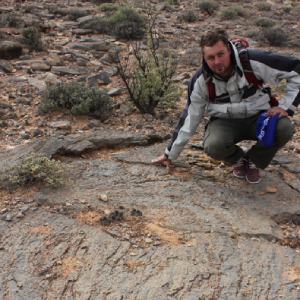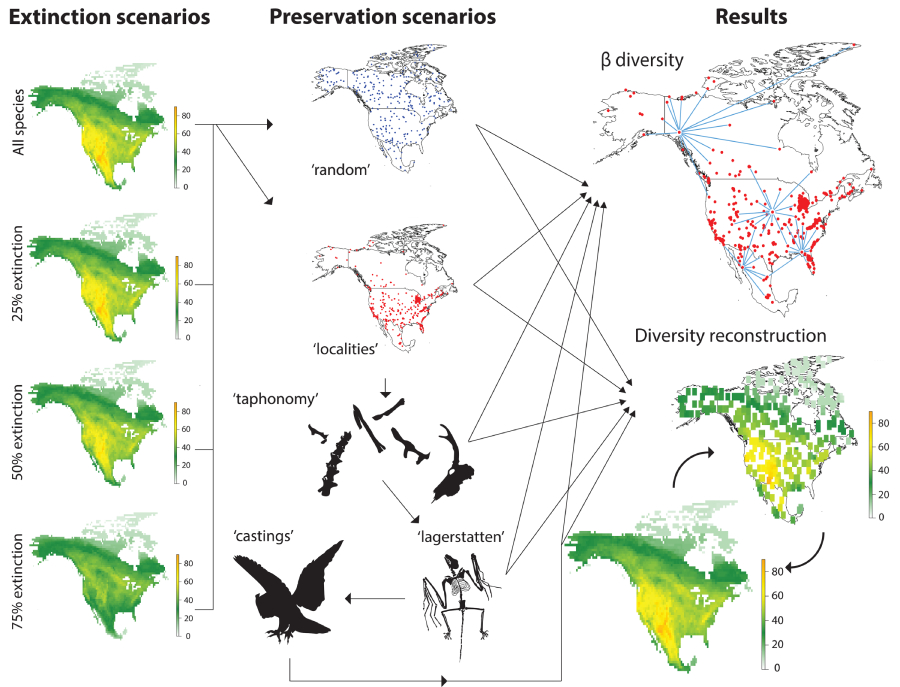Vanderbilt scientists use fossil records to understand the present, predict future ecosystems
by Marissa Shapiro Apr. 19, 2021, 9:00 AMBy Miquéla Thornton
Due to a multitude of human-driven impacts, the Earth is experiencing a biodiversity crisis. It has been referred to as the Sixth Mass Extinction, and scientists are examining similar events in the planet’s geological past looking for clues in ancient ecosystems to help us solve present-day issues.

Current events have produced dramatic changes in the distribution of species, altering a region’s time-specific ecosystem known as a biota, says Simon Darroch, assistant professor of Earth and environmental sciences. Darroch hopes there will be evidence of previous biota changes in the fossil record, such as undisturbed rock sequences that can place notable events and species to appropriate time periods. Yet, the extent to which biogeographic patterns or the distribution of animals can be preserved in the fossil record is not well understood.
In working toward solving this mystery, Darroch and a team of paleontologists and geobiologists used computers to simulate “fossil” records with the present-day distribution of 340 species to try to recover existing biogeographical patterns under varying hypothetical extinction scenarios. Darroch and his colleagues found that they could recover many biogeographic patterns—such as the size and location of biodiversity hotspots—with surprising accuracy. Co-authors on the study were Danielle Fraser at the Canadian Museum of Nature in Ottawa and Michelle Casey at Towson University.

The study, “The preservation potential of terrestrial biogeographic patterns,” was published in the journal Proceedings of the Royal Society B on Feb. 24. In studying the biotas under the simulations, the researchers accounted for numerous preservation biases, including the patchy distribution of fossil localities and the tendency for smaller animals to be less well-preserved in the fossil record. The latter was thought to represent an insurmountable barrier to reconstructing biogeographic patterns over extinction events because the majority of mammals tend to have small body sizes.
“Most ecologists are typically taught that small mammal fossils don’t preserve well because brittle skeletons get washed away,” Darroch said. However, he and his colleagues found that this can be compensated for by examining bird castings, specifically owl pellets. This matter is ideal for storing fossil records from tiny teeth to mammal skulls that otherwise go unobserved.
Overall, the research suggests the preservation potential of biogeographic patterns is surprisingly high. This means that fossil records are not only an invaluable archive for identifying species and events of the past, but they also present a vast library of ancient biogeography. The modeling shows that fossil records have the potential to tell scientists where biodiversity hotspots were during past biotic crises and to determine whether they are prone to moving or shrinking as the environment deteriorates. Reconstructing these changes may thus help scientists recognize which regions need protection as global ecosystems deteriorate.
“The project grew out of the pandemic,” Darroch said. “Without the ability to travel, we had to work out a new way to do cool science. Thus, numerical approaches like our computer simulation became more attractive. This is a novel approach, and the question of simulating fossil records with modern scenarios to see how well we can replicate the scenario is unusual. To the best of our knowledge, no one else is approaching the fossil record this way.”
The next step is prediction. Darroch and his team are working toward understanding how biodiversity hotspots will move with global warming and cooling. Further, they want to know, if there is a mass extinction, where it will be.
“I think this is justification for bringing paleontology into the fold of who gets to make decisions about conservation,” Darroch said.
While the approach is novel, Darroch and his team leveraged seminal research from paleontologist Kay Behrensmeyer to calculate the body mass of species and incorporated her foundational work on preservational biases into their study. “Dr. Behrensmeyer spent 30 years describing the processes that govern the transition from living organism, through death and decay and into the fossil record,” Darroch said. “We’re able to take her work from the 1970s and say, ‘This is just one crucial application we have for these data.’”
The funding for this project was provided by the Natural Sciences and Engineering Research Council of Canada discovery grant RGPIN-2018-05305, as well as support from the Alexander von Humboldt Foundation, sponsored by the Federal Ministry for Education and Research in Germany.
Read more:
- Darroch, Simon et al., “High preservation potential of paleogeographic range size distributions in deep time,” American Society of Naturalists, June 24, 2020
- Guarino, Ben, “Clinging on for grim death,” Washington Post, August 1, 2016
- Weisberger, Mindy, “Sack-Like Creatures Held Seafloor ‘Dinner Parties’ Half a Billion Years Ago,” Live Science, June 20, 2019